Bug bites are an all-too-familiar annoyance that can strike anytime, whether enjoying a quiet evening at home, running errands, or even sleeping soundly in your bed. Various insects can cause these minor, often itchy irritations, each leaving its unique mark.
In this illustrative picture guide, we’ll help you identify different types of bug bites, from bed bugs to spooky spiders, so you can better understand what might have bitten you and how to treat it. Whether you’re dealing with a mysterious bite or just curious to learn more, this comprehensive guide will help you identify bug bites with pictures and give you the insights you need to treat them effectively.
5 Types of Bug Bites & How to Identify Them With Pictures
Keep reading to learn more about 5 common types of bug bites and how to identify them with pictures!
1. Bed Bug Bites
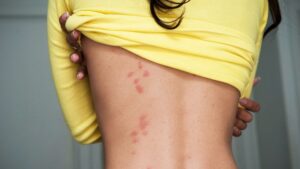
Image Source: https://www.goodrx.com/health-topic/environmental/bed-bug-treatment
Bed bugs often bite at night while you’re sleeping and target vulnerable areas such as the neck, hands, face, legs, arms, and shoulders. Symptoms can include itchiness, discomfort around the affected area, and even a burning sensation if you’re extra sensitive.
What do bed bug bites look like? Here are a few tell-tale signs of bed bug bites:
- Raised bumps, blisters, or pimple-like humps on the skin
- It has a similar appearance to hives, and after a few hours, bites can shrink to look like a pimple
- The skin around the bite may appear swollen or lighter in color
- Shaped in a line, zigzag, or random pattern
- Found in clusters of 3–5 bites
Has a bed bug bitten you? Immediately wash the bites with soap and water to avoid an infection. Apply a cream containing hydrocortisone and avoid itching the affected area. Aloe vera is also a soothing agent that can be applied to decrease irritation. If your reaction is extreme and you have trouble sleeping, consider taking an antihistamine such as Benadryl.
2. Tick Bites
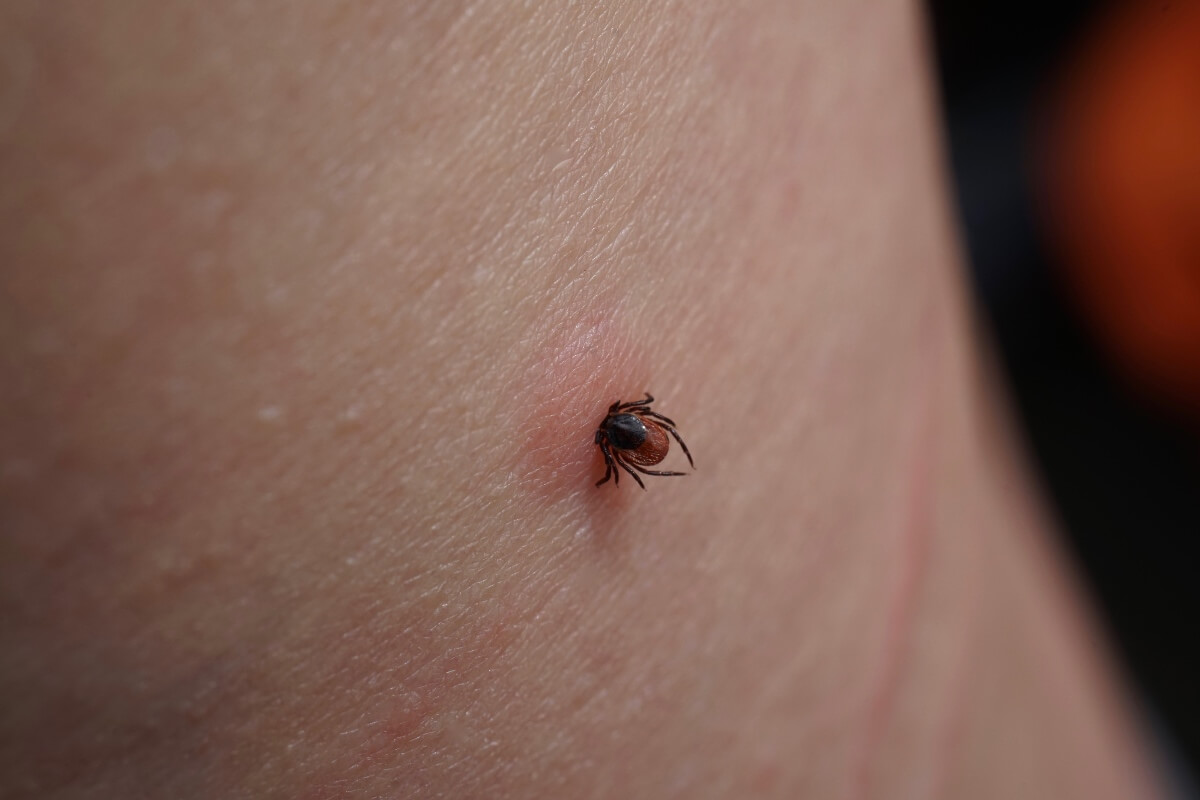
Tick bites are often painless and can go unnoticed for days. While some ticks are harmless, others infected can pass along germs or cause minor symptoms such as fever, headaches, muscle pain, and tiredness.
How to Identify Tick Bites: Ticks bite around the neck and scalp, between the legs, behind your knees, under your arms, or around the waist. After attaching themselves to the skin, ticks grow as they suck blood. If you find one, remove it as soon as possible. Using tweezers, grab the tick as close to your skin as possible and pull upward with steady, even pressure. The goal is to remove the tick in one piece. Once removed, thoroughly wash the affected area with soap and water.
The most common sign that a tick bite is more serious is a bulls-eye-shaped red rash. This rash can develop within 30 days of the bite, starting as a round spot and growing into a larger circle. If you spot a bulls-eye-shaped rash on your skin, it’s essential to speak with a medical professional. The picture below helps you identify what this bug bite looks like.
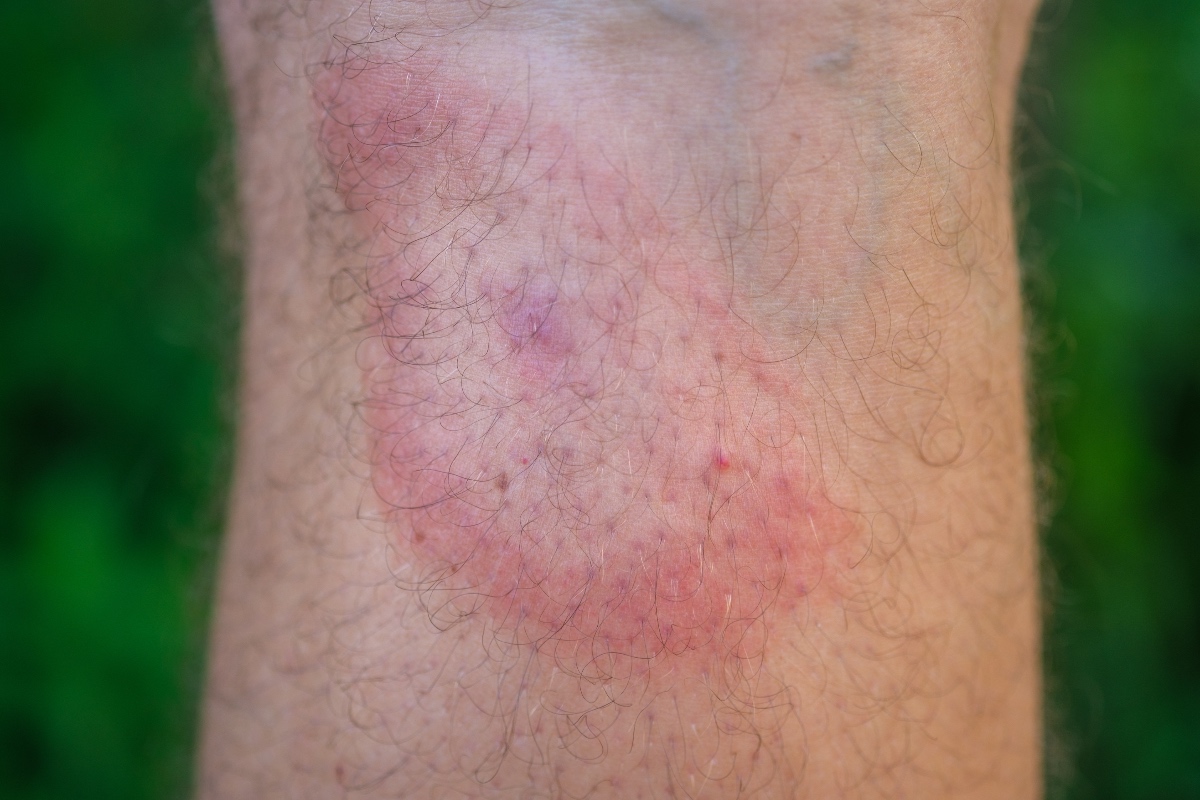
3. Lice Bites
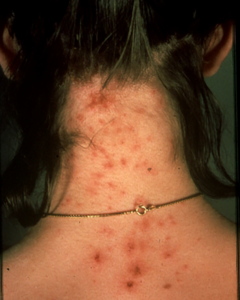
Image Source: https://www.prevention.com/health/a29476423/lice-bite-pictures/
There are 3 common types of lice, including hair lice, pubic lice, and body lice. Head lice are the most common, making their home in your hair, scalp, neck, or even eyebrows. Head lice spread most rapidly in school-aged children and are especially tricky to eliminate. Pubic lice infest the wiry hair around the genital area and sometimes in the underarm area or chest hair. These bugs are typically spread through sexual contact, so they’re most often found in sexually active teens and adults. Body lice feed everywhere besides the genitals and head and are often found in dirty homes.
How to Identify Lice Bites: Lice bites are fairly easy to identify since you’ll immediately feel itchy in the affected area. These bug bites often appear in clumps of small red or pink dots, and if itching excessively, they can become infected. Having lice is a highly unpleasant experience that needs to be treated immediately to dissipate the discomfort.
To treat lice, you’ll need to purchase an over-the-counter prescription to kill hair and pubic lice, but it’s also essential to eliminate the nits. Combing out nits is the most effective method, and you’ll also need to wash all clothes and bedding in hot water (130℉) that may be infested with lice. Body lice are rare, but if you’d like to prevent these bugs, ensure you’re implementing good personal hygiene practices, healthy living conditions, and washing clothes consistently.
4. Flea Bites
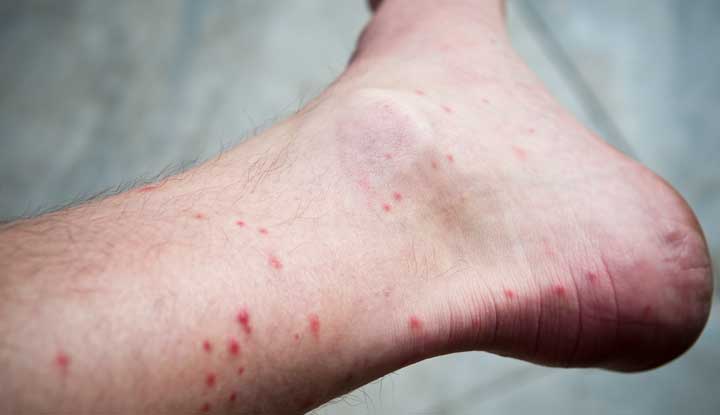
Image Source: https://my.clevelandclinic.org/health/diseases/21718-flea-bites
Fleas are active in warmer months and hop onto animals when they walk by. Fleas live around the ears, neck, back, and belly of animals and often jump off an infested animal to hide once inside your home. While fleas can bite humans, they usually live on dogs or cats since they prefer furry creatures that allow them to hide more easily.
How to Identify Flea Bites: Flea bites appear as small red bumps in clusters or a straight line. A halo or ring may form around the bite over time. Flea bites are often found on the legs, especially your feet, ankles, or calves. These bug bites rarely appear above the knee, making them easily distinguishable. Bites are itchy and, in rare cases, can cause an allergic reaction, such as hives, shortness of breath, and swelling.
Flea bites don’t need to be treated and often disappear over time. However, if the itchiness disturbs your day-to-day life, over-the-counter itch cream may be helpful. If symptoms worsen, you must talk to a healthcare provider about what you’re experiencing.
5. Mosquito Bites
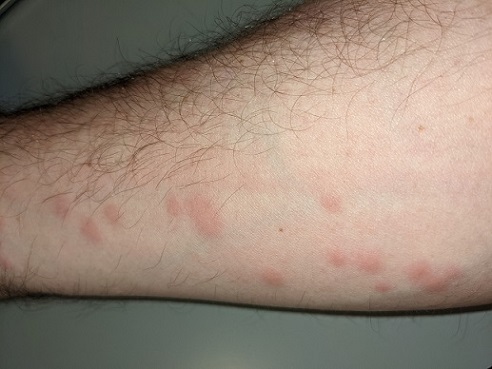
Image Source: https://drs.illinois.edu/Page/SafetyLibrary/Mosquitos
Mosquitoes are pesky bugs, most common in warmer parts of the world and during spring or summer. Only females feed off of human blood. When they bite, female mosquitos use their mouthpart to pierce your skin, suck your blood, and secrete saliva into the bloodstream.
How to Identify Mosquito Bites: Mosquito bites are small, raised red bumps that appear on the skin. Mosquitos can bite anywhere on the skin but commonly target the arms, neck, legs, or other exposed areas. Due to your body’s to the mosquito’s saliva, the affected area will feel itchy. Mosquito bites don’t need to be treated unless symptoms worsen.
Mosquitos can spread diseases such as Malaria, Dengue, or Zika, but this is rare in the US. If you’ve been bitten and start experiencing headaches, a fever, body aches, or other intense symptoms, contact a health professional immediately.
3 Common Spider Bites & How to Identify Them
If you’ve been bitten, it’s essential to determine whether it’s a bug bite or a spider bite. Spiders are often harmless unless threatened. However, in rare cases, spiders can bite and cause severe to mild symptoms. Here are 3 common types of spider bites with pictures to identify them and how to treat the affected area effectively:
1. Brown Recluse Spider Bites
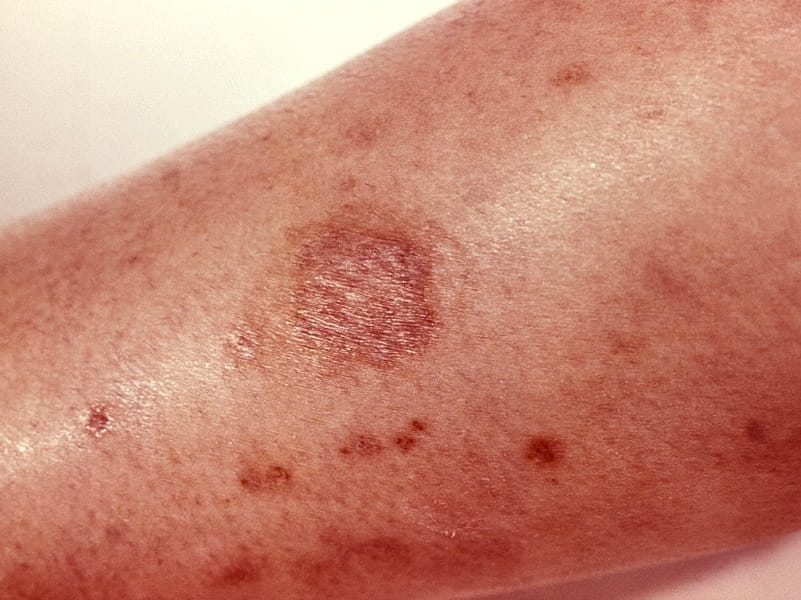
Image Source: https://www.poison.org/articles/brown-recluse-spider-bites
Contrary to popular belief, brown recluse spiders are not usually aggressive. Unless actively threatened (trapped under your skin), they avoid humans as much as possible. Brown recluses are ⅓ inches long and have a dark brown marking on their backs.
How to Identify Brown Recluse Spider Bites: Initially, a brown recluse spider bite is painless, but within 2–8 hours, it will start to itch, hurt, and turn red. A red ring can form around the affected area, giving it a bulls-eye appearance. The spider bite can blister and possibly kill surrounding tissue or cells, as pictured above. While brown recluse bites often only cause mild discomfort, they can instigate seizures, jaundice, comas, or blood in urine on infrequent occasions.
If you’ve been bitten, your doctor can prescribe antibiotics if necessary. Ensure the affected area is washed with gentle soap and water before contacting a healthcare professional.
2. Black Widow Spider Bites
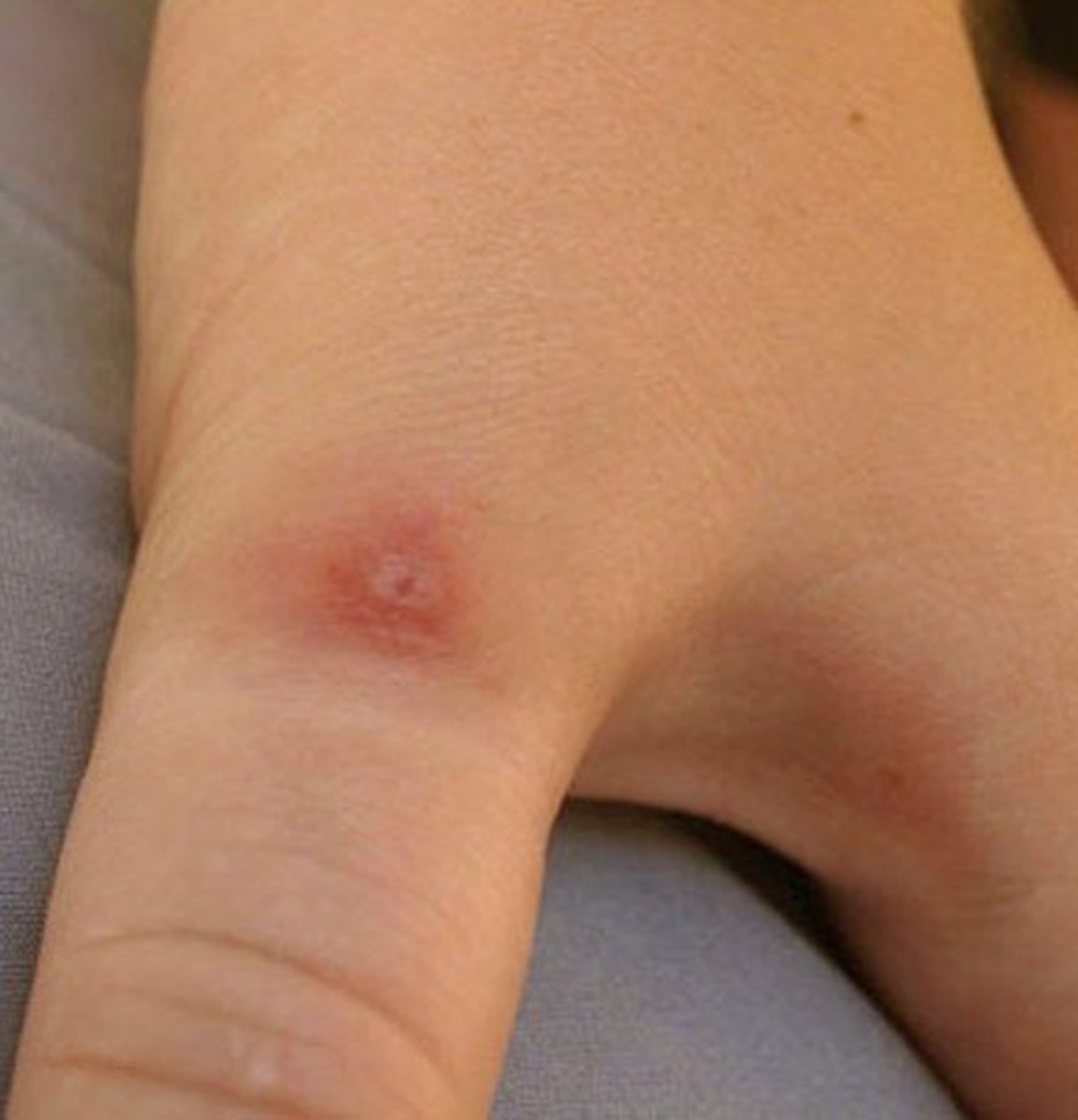
Image Source: https://u.osu.edu/kennedy1306/black-widow-spider/
Black widows are shiny black spiders. Females have a recognizable red hourglass shape on the underside of their bodies. Females are larger and more dangerous than males and are the only ones that bite humans. Black widow spiders only bite if they feel threatened or are trying to protect their eggs.
How to Identify Black Widow Spider Bites: When a female black widow bites, you may spot tiny red fang marks at the affected area. You may also experience mild redness or swelling in the bite area. Over time, a blister may form, or you may experience an itchy skin rash. In more extreme cases, your skin can turn bluish-gray at the bite site.
You’ll feel an immediate pinprick of pain and a dull numbness when bitten. Black widow spider venom disrupts with chemicals in your nerve endings, causing severe pain, stiffness, or muscle spasms. A few other symptoms caused by black widow spider bites include:
- Swollen or droopy eyes
- Headaches
- Nausea or vomiting
- Trouble breathing
- Fever and chills
- Excessive sweating
If a black widow has bitten you, wash the affected area with soap and water and apply an ice pack to reduce pain and delay the symptoms caused by the venom. If possible, elevate the wound. Don’t try to remove the venom alone. Instead, call the National Capital Poison Control Center (1-800-222-1222) and seek medical attention.
3. Wolf Spider Bites
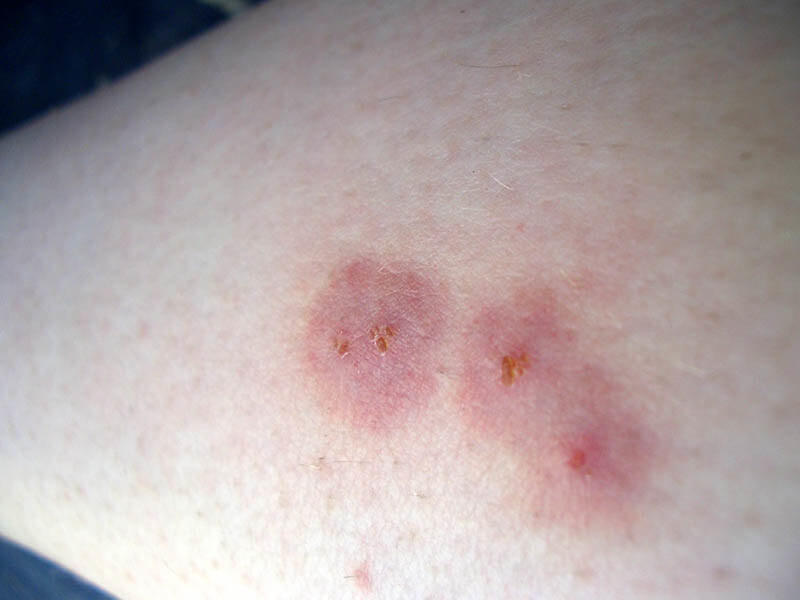
Image Source: https://everythingspiders.com/wolf-spider-bites/
Wolf spiders are one of the most common types of spiders and can be found in various environments. They’re not usually aggressive unless threatened or trapped by humans.
How to Identify Wolf Spider Bites: A wolf spider bite can look like a typical bug bite, appearing as a red, swollen bump on the skin. It may leave fang-like marks and result in itching or mild pain. Wolf spider bites are often harmless but can result in an allergic reaction and instigate swelling, hives, or a red line extending from the affected area.
Treatment depends on the reaction to the wolf spider bite. Start by cleaning the bite with warm water and soap. Apply an ice pack or cold washcloth to the bite to soothe itching and discomfort. If needed, take an antihistamine or over-the-counter pain reliever to ease swelling. Symptoms should clear within a few days; however, if they don’t, contact a healthcare provider.
Avoid Bug Bites With Preventive’s Extermination Team
Bugs are around year-round, especially in a warm climate like Southern California. Bed bugs, mosquitos, spiders, and other pesky critters run rampant in this warm coastal state. If you’d like to avoid the discomfort, itchiness, or severe symptoms of common bug or spider bites, it’s essential to safeguard your Southern California property from pests. Preventive Pest Control is the top-rated extermination company in Orange County and the Inland Empire.
For over 20 years, we’ve helped residents protect themselves and those they care about from annoying and possibly dangerous pests. With our Temprid technology and ongoing subscription plans, Preventive’s team eliminates pests from homes and commercial businesses and prevents them from returning. Don’t let pests enter your property and put yourself and others at risk of being bitten. Contact us today to experience a pest-free environment and live with peace of mind, knowing you’re safe from bug bites.
